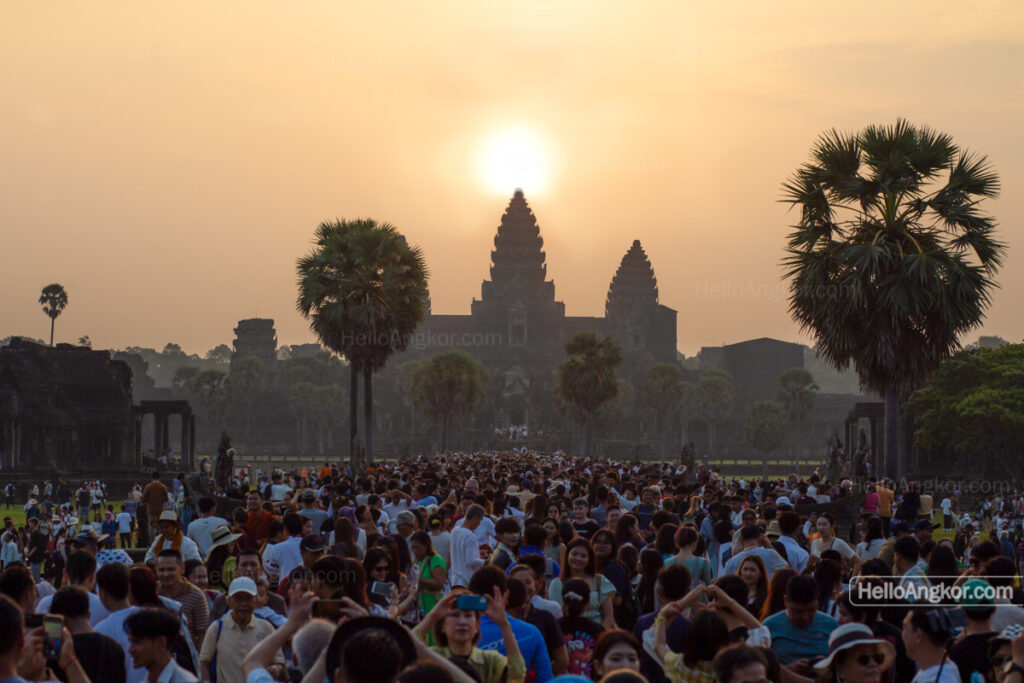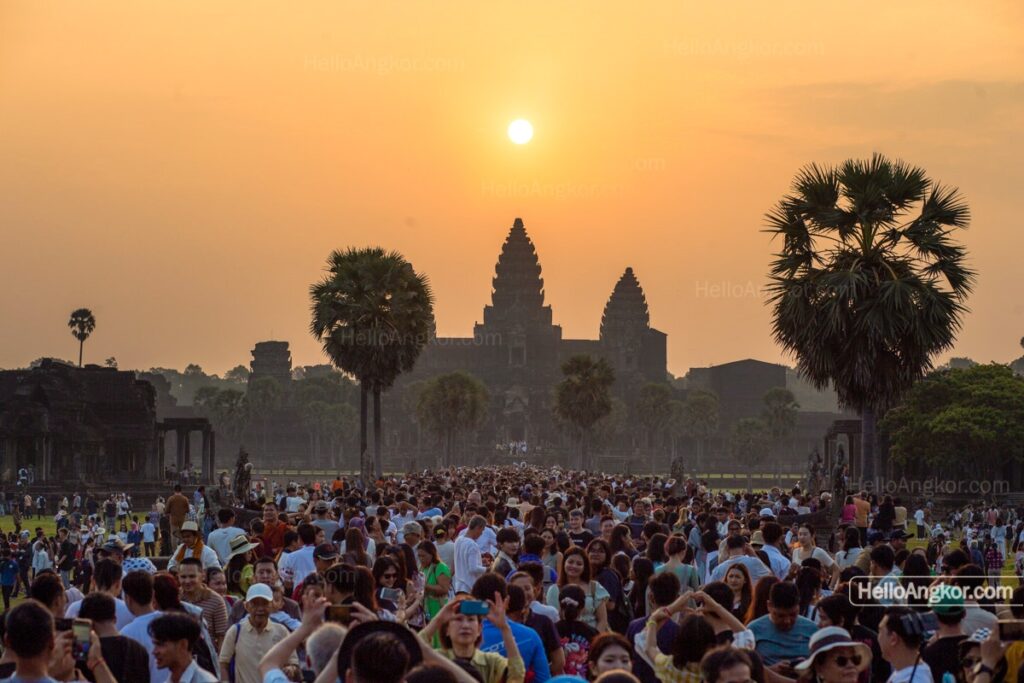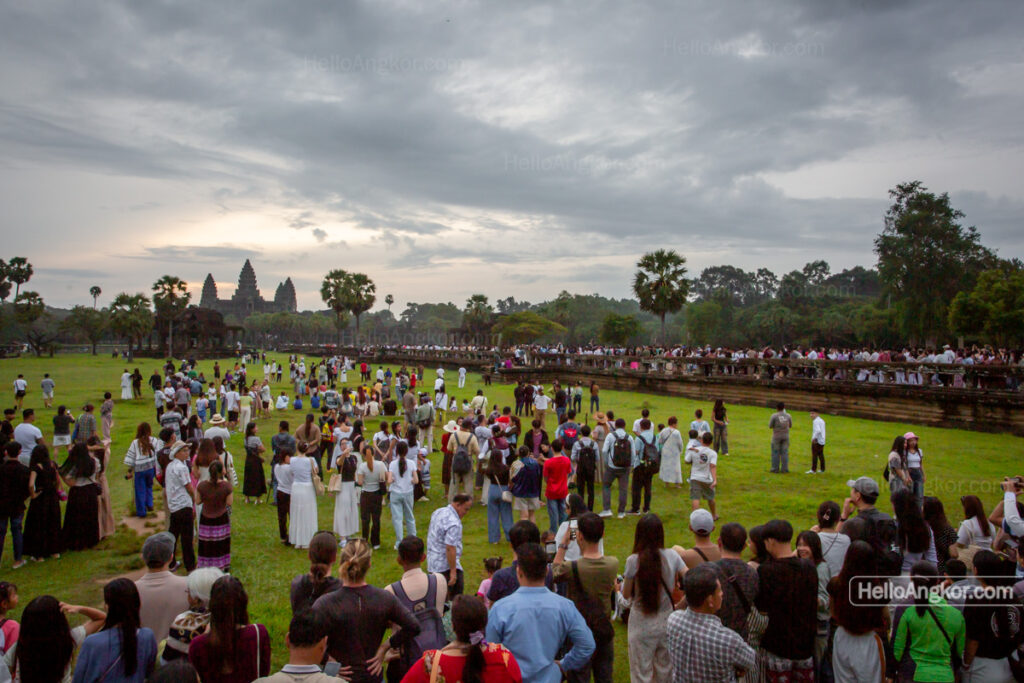The Angkor Wat Equinox Event offers a unique opportunity to witness the architectural and astronomical mastery of the ancient Khmer civilization. It truly is one of the world’s most unique experiences, where man meets the astronomical world through the vision of the ancient master architects. This guide will provide you with all the information you need to experience this magical event.
Jump to: Introduction | What is the Equinox? | The Angkor Wat Equinox Event | History and Significance | Dates and Times | Getting There | Tickets and Entry | Tips for Visitors | Other Archeo-Astronomical Events
Introduction

Twice a year, a remarkable event occurs at the ancient temple of Angkor Wat in Cambodia. As the sun rises on the morning of the equinox, it aligns perfectly with the central tower of the temple, creating a stunning visual spectacle.
It’s an almost magical experience that exposes the mastery of the ancient Khmer architects and, moreover, a manifestation of the sacred into a living experience.
Thousands of people flock to the city of Siem Reap filling the hotels and guesthouses from where they’ll depart in the wee hours of the morning and head 6 km north to the western entrance of Angkor Wat.
Crowds are usually upwards of 10,000 for each of the three days while in September 2024, visitor numbers for one day reportedly topped 12,000 for the first time.
What is the Equinox?
The solar equinox is the time of the year when the Sun is positioned directly above the Earth’s equator. This results in nearly equal amounts of daylight and nighttime across the globe. There are two equinoxes each year:
- Spring (Vernal) Equinox: Occurs around late March in the Northern Hemisphere, marking the beginning of spring. In the Southern Hemisphere, it signals the start of autumn.
- Autumnal Equinox: This happens around late September in the Northern Hemisphere, indicating the start of fall. In the Southern Hemisphere, it marks the beginning of spring.
During an equinox, the Earth’s axis is neither tilted towards nor away from the Sun, leading to this balance in day and night length.
The Angkor Wat Equinox Event
Angkor Wat was built in the early 12th century, with researchers hypothesising that it was originally constructed as a Hindu temple dedicated to the god Vishnu. It was later converted into a Buddhist temple as it remains today. The temple’s design incorporates sophisticated archeo-astronomical alignments, including that which coincides with the bi-annual equinox.
The alignment of the sun with the central tower during the equinox is believed to have held great religious and symbolic significance for the ancient Khmer people. It may have represented the balance between the physical and spiritual worlds or served as a calendar marker for important agricultural or religious events.
While there’s no epigraphic evidence that the ancient Khmer celebrated the equinox at Angkor Wat, the precise architectural alignment suggests that it was an intentional and important feature of the temple’s design.
Dates and Times
The Angkor Wat Equinox Event occurs twice a year:
- Spring Equinox: Usually around March 20-21
- Autumn Equinox: Usually around September 22-23
The exact dates can vary slightly from year to year, so it’s best to check around the start of the month (March or September) for precise dates. It takes place over three days and some like to go on each day, and some like to go on the middle day. It’s up to you.
The March equinox takes place during the dry season and generally always produces the most stunning display of color and intensity. September is mid-rainy season and is often cloudy occasionally blocking the chance to see the sun in alignment with the temple tower. Regardless, both events draw huge crowds
You’ll need to wake up around 4/4.30AM and get on your way to the temple. Angkor Wat opens at 5.00 AM and it’s recommended to get there around that time and choose your position and also enjoy the break of day which often presents a range of colors.
These times are based on last year’s Autumn equinox event and the Spring Equinox is similar:
- Around 5:20 AM the sun still sits below the horizon and morning twilight begins. The light bounces off any clouds sometimes creating a wonderful array of colors, contrasting against the unlit temple.
- Around 6:00 AM, daybreak arrives and the sun starts to emerge from behind the temple. It takes about 15 minutes or so to ascend above the tower’s peak.
- Around 6.23 AM, the sun sits perfectly behind the peak of the temple tower creating a stunning fusion of man, temple, and the universe.
- Around 6:25 AM, the sun is well on its way above the temple.
Tickets and Entry
To enter Angkor Archaeological Park, which includes Angkor Wat, you need to purchase a pass:
- 1-day pass: $37
- 3-day pass: $62
- 7-day pass: $72
Passes can be purchased in advance at the official ticket office on the road from Siem Reap to Angkor Wat or purchased online, only at angkorenterprise.gov.kh. More about tickets here
Getting There
Angkor Wat is located about 6 km north of Siem Reap, Cambodia. Here are the main ways to get there:
- Tuk-tuk: A popular and affordable option. Arrange with your hotel or book in advance with Grab or PassApp.
- Bicycle: Many hotels offer bicycle rentals. It’s a flat 6 km ride from Siem Reap but of course, you’ll need to leave a bit earlier.
- Scooter: It is legal for foreign guests to ride electric scooters which can be hired in Siem Reap.
- Private car or van: Hire a driver through your hotel or book in advance with Grab or PassApp.
- Organized tour: Many companies and tour guides offer sunrise tours to Angkor Wat.
There is secure ticketed parking at the western entrance to Angkor Wat which costs 50 cents.
Where’s the best viewpoint?
There are numerous options, I’ll list the popular spots and alternatives
- Outer Moat – grab a seat at the edge of the outer moat, north or south of the causeway. It’s usually a peaceful spot but the positions with the perfect angle are limited. You can watch the sun come up over the tower peak and the entire complex, and, also get the reflection of the sun and temple in the waters of the moat.
- West Gopura (entrance pavilion) – standing on the stairs here gives you a raised view looking straight along the entrance causeway and the centerline of the temple. There are limited spots and everyone wants that position :). Many choose to sit on the ledge on either side of the causeway, but those spots can get filled quickly too.
- Central Causeway – a centerline view, standing room only and you’ll need to hold your camera up high to get decent shots. If you head closer to the temple, the crowd thins out and it’s a bit more comfortable.
- North and South Libraries – you won’t be on the centerline, but the views are still impressive.
- North and South Ponds – these are the classical Angkor Wat sunrise spots and they still work well for the equinox event.

Here’s a bonus spot if you have a zoom lens, try the entrance road between the carpark and the western gopura. See more tips for Sunrise at Angkor Wat here.








Tips for Visitors
- Arrive early to secure a good viewing spot.
- Bring a flashlight for navigating in the pre-dawn darkness.
- Wear comfortable shoes and modest clothing (shoulders and knees should be covered).
- Bring water and snacks.
- Consider hiring a guide for historical context and the best viewing locations.
- Be prepared for crowds
- Respect the site: it’s an active religious monument.
Are there other Archeo-Astronomical Events in Angkor?
According to a research paper, Archaeoastronomy In the Khmer Heartland by Giulio Magli, several other temples have fascinating astronomical alignments including:
- Bakong – Oriented at an azimuth of 89.5°, it showcases the same phenomenon as Angkor Wat but at sunset during equinoxes, with the sun setting directly behind the temple.
- Phnom Bakheng – Another example with a similar alignment to Bakong (azimuth 89.5°) and associated equinox sunset observations.
- Bayon – This temple shares an almost identical alignment to Angkor Wat but is oriented slightly north of east (azimuth 89.5°), with the sunset crowning its central structure during equinoxes.
Sites outside Angkor:
- Koh Ker – This temple complex has an azimuth of 76°, aligned with the sun’s rising on the days of the zenith passages (when the sun is directly overhead), making it unique among Khmer state temples.
- Preah Khan of Kompong Svay – Oriented toward the rising moon during the northernmost lunar standstill, with an azimuth of 61°, showing an explicit connection to lunar cycles. It also shares a latitude with Angkor Wat, suggesting symbolic or ritual significance.
Zenith Passages
Another interesting archeo-astronomical alignment is the days of the zenith passages. In Angkor, on April 26 and August 17, the sun passes directly overhead at noon, an event known as the zenith passage. During these moments, objects cast no shadows, creating a unique visual effect.
In 2011, researchers Edwin Barnhart and Christopher Powell published a paper, The Importance of the Zenith Passage in Angkor Cambodia, hypothesising that the builders of Angkor’s temples seemed to have been well aware of this celestial event and incorporated it into their architectural designs. In their study they propose that the temple towers feature holes in their roofs that allow the zenith passage sunlight to shine directly down into the inner chambers, illuminating the sacred linga-yoni/idol altars placed at the center of the temple floors.
This alignment may have held deep spiritual significance, symbolically connecting the temples, viewed as earthly mountains, to the center of the heavens. They also argue that the importance of the zenith passage is further evidenced by its apparent encoding in temple artwork and the spacing of certain architectural elements.
